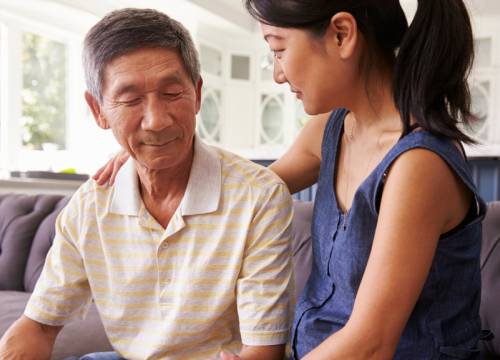Fatigue
If you experience fatigue and sleep problems, you are not alone. These are common symptoms of Parkinson’s disease (PD). In fact, fatigue can occur at any stage of Parkinson’s, and many people report that fatigue is one of the symptoms that affects them the most. It can have a greater impact on your quality of life than motor symptoms like stiffness, slowness or walking problems.
But doctors don’t always ask about fatigue, and people with Parkinson’s and their care partners don’t always know to bring it up. So how can you cope with and manage fatigue to feel your best? First, it is important to understand the causes. Then you can learn strategies to ease its impact.
What Is Fatigue?
Fatigue is a feeling of being extremely tired, of being either physically or mentally weary. Most people talk about fatigue as a result of some type of exertion—being tired from working or from thinking—but sometimes it is there all the time. It is different than sleepiness. When you’re sleepy, you want to fall asleep and can do so easily. No matter how extreme, fatigue does not usually result in sleep, even in sedentary situations.
People who are fatigued struggle to get through normal daily activities. They have difficulty concentrating and sleeping, decreased stamina, issues with memory and productivity, and even anxiety and depression. You might find yourself skipping social engagements because you feel like you just don’t have the energy or motivation. If you notice any of these symptoms and feel fatigued, talk to your healthcare provider.
Causes of Fatigue
Biology
In Parkinson’s, fatigue is not just your body’s reaction to PD symptoms, or not sleeping well. Fatigue can be a result of the same brain changes that lead to motor symptoms, though the level of fatigue is not necessarily related to the severity of motor symptoms. People who have severe fatigue early in their Parkinson’s tend to stay fatigued.
Lifestyle
While it might sound counterintuitive, not exercising and leading a sedentary lifestyle can actually increase your fatigue.
Tip: Fight Parkinson’s and fatigue by exercising at least 2.5 hours per week for a better quality of life.
Medications
Dopamine agonists (e.g., ropinirole/Mirapex and pramipexole/Requip) can cause fatigue and daytime sleepiness.
Tip: Reducing these medication may help. However, it is a delicate balance between good motor symptom control and excessive fatigue.
Akinesia
Akinesia, or trouble starting a movement, often feels like fatigue. A person with this symptom must move slowly and will find it hard to finish a task in a regular amount of time. Everyday tasks such as getting dressed can take a lot of effort, as it takes more concentration to perform tasks that are no longer automatic.
Tip: Keep track of times during the day when akinesia is better and medications are working well. Energy-consuming tasks can then be done at these times when movement is easier.
Muscle Fatigue
PD symptoms like muscle stiffness, cramping, tremor or shaking, and akinesia put stress on a person’s muscles. To move with these symptoms, muscles have to work hard and often against each other. With tremor, the constant shaking can quickly fatigue muscles. On the other hand, muscles that do not move enough are not well-conditioned, and they can become smaller (atrophied). Loss of muscle strength decreases stamina and endurance. For many people, this decrease feels like fatigue.
Tip: As described above, some Parkinson’s motor symptoms can cause fatigue. Anti-Parkinson’s medications treat motor symptoms, which in turn can help reduce fatigue. However, after being on dopaminergic therapy for a while, many people experience dyskinesia (fidgety, involuntary movements). Like tremor, these movements can also cause fatigue. The only treatment available to keep muscles well-conditioned is a regular exercise program. People who include exercise as a part of their daily routine have less fatigue!
Changes in Mobility
Many people with Parkinson’s disease experience changes in their ability to move throughout the day. These changes are often related to when you take your medications. You are better able to move after your medications take effect, and you might find it more difficult to move as the medication wears off, before your next dose.
Tip: Often, people try to get everything done in the morning after their first dose of medication, when they feel well and rested. But too much activity in the morning can lead to fatigue. Time your periods of activity for maximum mobility, but also pace yourself and allow for rest periods.
Insomnia
Some sleep disorders, like sleep apnea and restless legs syndrome, contribute to daytime sleepiness, but people with insomnia complain of fatigue.
Tip: If nighttime insomnia is a problem, avoid naps during the day, which can make you less sleepy at night.
Depression
It is estimated that at least 50% of people with Parkinson’s will experience some form of depression during their illness. Fatigue is a common symptom of depression and is often reported as a lack of motivation or a loss of energy.
Tip: A combination of counseling and medication is most effective at treating depression. When successful, people begin to feel less tired and are more willing to participate fully in activities.
Working with Your Healthcare Provider to Manage Fatigue
If you are experiencing fatigue, ask yourself the following questions. Record the answers in a notebook or on your smartphone, and bring this information to your next doctor’s appointment.
• When do I feel fatigued?
• How long do my feelings of fatigue last each day?
• Does my fatigue change with my PD symptoms?
• Does my fatigue change with the time that I take my medications?
• On a scale of one to ten, how fatigued am I in the morning, around noon, and in the afternoon?
The answers to these questions can help you and your doctor work together to identify possible causes of the fatigue you are experiencing. To understand and address it, and to rule out non-Parkinson’s causes, your healthcare provider will take a complete health history and do a physical exam. Sometimes problems not associated with PD, such as anemia, can explain the fatigue. If necessary, Parkinson’s medications can be adjusted.
The Parkinson’s Foundation is committed to better understanding how to help people with PD overcome Fatigue. In 2017, we provided funding to two researchers studying fatigue.
Hengyi Rao, Ph.D. at University of Pennsylvania is studying Multi-modal Neuroimaging of Fatigue in Parkinson’s Disease.
This study will use neuroimaging to observe the brain changes underlying fatigue and will explore the use of blue light as a potential treatment. A therapy exposing the eyes to blue light has proven to decrease daytime sleepiness in people with traumatic brain injuries. This study will explore whether this remedy may also be beneficial for in people with PD.
Milton Biagioni, M.D. at New York University is studying Remotely Supervised Transcranial Direct Current Stimulation (tDCS) for At-home Treatment of Fatigue and Cognitive Slowing in Parkinson’s Disease.
This study looks at whether a non-invasive, brain stimulation device paired with online cognitive training could alleviate fatigue and cognitive slowing in people with PD. This study uses a specially designed tDCS device through a new method of remote supervision.
Treating Fatigue
Medications for Parkinson’s motor symptoms do not necessarily improve fatigue, although one study found that levodopa slowed the worsening of fatigue.
Research in this area is in its early stages. Testosterone replacement and modafinil were tested but proved unsuccessful in the treatment of fatigue. In a small trial, methylphenidate (Ritalin) was found to be effective, but this and other stimulants have not been approved for treating Parkinson’s disease. More studies are needed.
To date, exercise is the best known therapy for fatigue. People with Parkinson’s often say that they are too fatigued to exercise, but you will likely find that you actually feel more energetic after you exercise! When exercising, you should have reasonable expectations. Start slowly by walking or using an exercise bicycle for five minutes, and build up to 30 minutes a day.
Done safely, there is no down side to exercise. It not only helps improve fatigue, but also can have a positive impact on overall sense of well being, depression and sleep quality at night.
TIP: Maximize Energy and Endurance
-
Try to identify and reduce the major sources of stress and fatigue in your daily routine.
- Exercise regularly to build endurance and stamina.
- Keep mentally active. Boredom often leads to fatigue.
- Schedule adequate time for rest and sleep in your daily routine.
- Plan the highest level of activity and the most difficult daily tasks at times you are well rested and medications are working well.
- Take frequent breaks.
- Know your limits. Forcing too many activities into one time period will cause fatigue.
- Get help when needed. Delegate or hire help for tasks you find particularly stressful or tiring.
- Involve Your Team. Consult with an occupational therapist for an assessment and individual recommendations for energy conservation and enhancement.
Related Materials
Exploring Non-Motor Symptoms: Neuropathy, Fatigue, GI Issues
Expert Briefing: Non-motor Symptoms: What’s New?
Related Blog Posts


Tackling Neuropathy, Fatigue and GI Issues in PD
